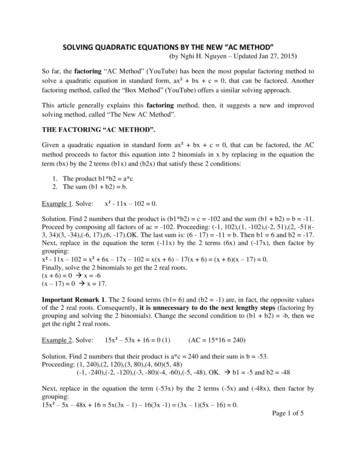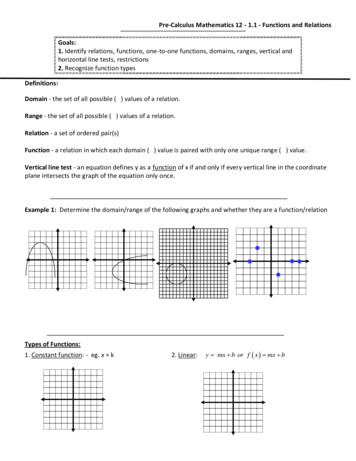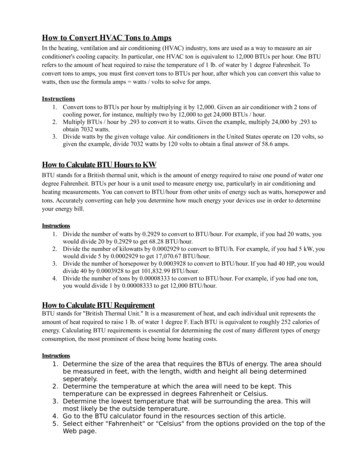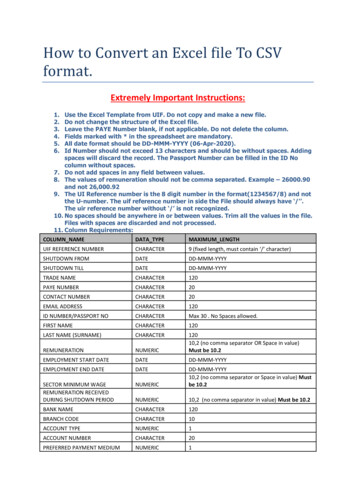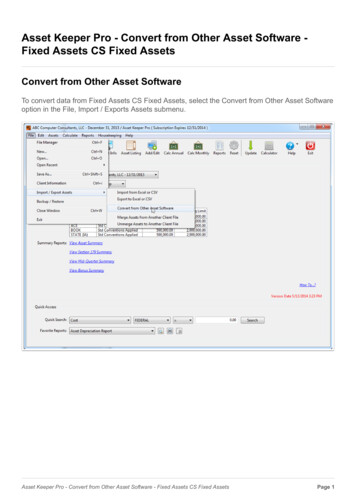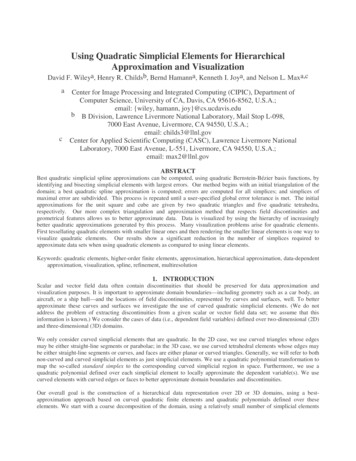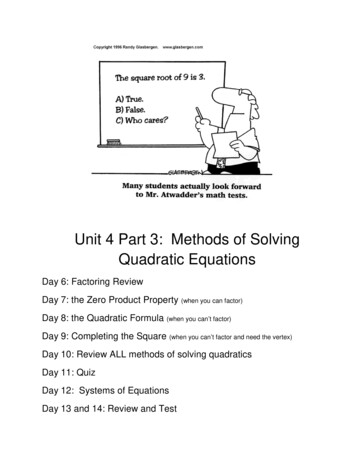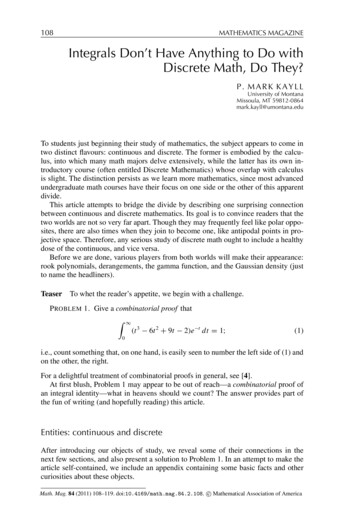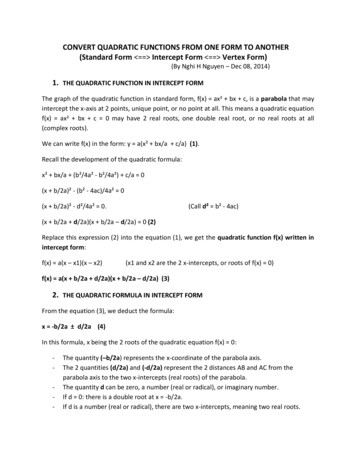
Transcription
CONVERT QUADRATIC FUNCTIONS FROM ONE FORM TO ANOTHER(Standard Form Intercept Form Vertex Form)(By Nghi H Nguyen – Dec 08, 2014)1. THE QUADRATIC FUNCTION IN INTERCEPT FORMThe graph of the quadratic function in standard form, f(x) ax² bx c, is a parabola that mayintercept the x-axis at 2 points, unique point, or no point at all. This means a quadratic equationf(x) ax² bx c 0 may have 2 real roots, one double real root, or no real roots at all(complex roots).We can write f(x) in the form: y a(x² bx/a c/a) (1).Recall the development of the quadratic formula:x² bx/a (b²/4a² - b²/4a²) c/a 0(x b/2a)² - (b² - 4ac)/4a² 0(x b/2a)² - d²/4a² 0.(Call d² b² - 4ac)(x b/2a d/2a)(x b/2a – d/2a) 0 (2)Replace this expression (2) into the equation (1), we get the quadratic function f(x) written inintercept form:f(x) a(x – x1)(x – x2)(x1 and x2 are the 2 x-intercepts, or roots of f(x) 0)f(x) a(x b/2a d/2a)(x b/2a – d/2a) (3)2. THE QUADRATIC FORMULA IN INTERCEPT FORMFrom the equation (3), we deduct the formula:x -b/2a d/2a (4)In this formula, x being the 2 roots of the quadratic equation f(x) 0:-The quantity (–b/2a) represents the x-coordinate of the parabola axis.The 2 quantities (d/2a) and (-d/2a) represent the 2 distances AB and AC from theparabola axis to the two x-intercepts (real roots) of the parabola.The quantity d can be zero, a number (real or radical), or imaginary number.If d 0: there is a double root at x -b/2a.If d is a number (real or radical), there are two x-intercepts, meaning two real roots.
-If d is imaginary, there are no real roots. The parabola doesn’t intercept the x-axis.-The unknown quantity d can be computed from the constants a, b, c by this relation (5):d² b² – 4ac(5)We can easily obtain this relation by writing that the product (x1*x2) of the 2 real roots is equalto (c/a).(-b/2a d/2a)(-b/2a – d/2a) c/ab² – d² 4ac d² b² – 4acIf d ² 0, there is double root at x -b/2aIf d² 0, there are 2 real roots.If d² 0, there are no real roots, there are complex roots.Page 2 of 9
To solve a quadratic equation, first find the quantity d by the relation (5), then find the 2 realroots by the formula (4).REMARK. This new quadratic formula in intercept (graphic) form is simpler and easier toremember than the classic formula since students can relate it to the x-intercepts of theparabola graph. In addition, the two quantities (d/2a) and (-d/2a) make more sense aboutdistance than the classical quantity: (b 2 – 4ac).3. CONVERT QUADRATIC EQUATIONS FROM STANDARD FORM TO VERTEX FORMProblem. Given f(x) ax² bx c.Find x1 and x2 to convert f(x) to intercept form: f(x) a*(x – x1)(x – x2)Solution. To convert a function, from standard form f(x) ax² bx c, to intercept form, weuse the general intercept form expression (3).f(x) a*(x b/2a d/2a)(x b/2a – d/2a), with d² b² - 4ac.a. If d is real, whole number ( 3, 14, 76 ), or fraction ( 3/5, 23/47 ), there are 2 xintercepts. f(x) can be factored and f(x) can be converted to intercept form.Examples: f(x) (x – 7)(x 8); y (x 3)(x 23);f(x) (3x – 5)(7x – 13); y (5x – 7)(6x – 5)b. If d is radical ( 5, 13, 71 ), there are 2 x-intercepts. f(x) can’t be factored.However f(x) can be converted to intercept form. See Example 10 and 11.Examples: f(x) (x – 1/2 5/2)(x – 1/2 - 5/2); f(x) (x - 2/3 - 3/3)(x – 2/3 3/3)c. If d is imaginary ( 3i, 17i ), there are no x-intercepts, and there is no interceptform.Example 1. Convert y 5x² 6x – 8 into intercept formSolution. First find d² 36 160 196 d 14 and d - 14. Substitute the values of d, a, b, cinto (3), we get y in intercept form.y 5*(x 6/10 14/10)(x 6/10 – 14/10)y 5*(x – 4/5)(x 2) (5x – 4)(x 2).Page 3 of 9
Example 2. Convert y 7x 2 18x – 25 to intercept formSolution. First find d² 324 700 1024 d 32 and d -32.y 7*(x 18/14 - 32/14)(x 18/14 32/14)Intercept form: y 7*(x - 1)(x 25/7) (x – 1)(7x 25)Example 3. Convert y 16x² 34x – 15 to intercept form.Solution. First find d² b² – 4ac 1156 960 2116 d 46 and d -46Since d is a whole number, we can either factor the equation, or use the formula.Factoring gives the intercept form: y (8x – 3)(2x 5)Example 4. Convert y 9x² 4x – 1 to intercept formSolution. d² 16 36 52 4*13 d 2 13 and d -2 13.Replace values of d, a, b, c into the general expression (3).Intercept form: y 9[x (2 13)/9)(x (2 - 13)/9).y 1/9(9x 2 13)(9x 2 - 13)Back check. We may check the answer by multiplying the 2 factors:y 1/9[(9x 2)² - 13] 1/9*(81x² 36x 4 – 13) 9x² 4x - 1Example 5. Convert y 9x² - 12x 1 to intercept form.Solution. d² 144 – 36 108 36*3 d 6 3 and d -6 3.Intercept form: y 9(x - 2/3 3/3)(x - 2/3 - 3/3) (3x – 2 3)(3x – 2 - 3)Back check. We may check the answer by multiplying the 2 factors:y (3x – 2)² - 3 9x² - 12x 4 – 3 9x² - 12x 14. CONVERT QUADRATIC FUNCTIONS FROM STANDARD FORM TO VERTEX FORMWe can convert a quadratic function from standard form, y ax² bx c, to the general vertexform: y a(x p)² q. We don’t need to factor the quadratic equation because factoring is onlya special case of finding the 2 real roots. The below method is generally better.Problem. Given a quadratic function in standard form: f(x) ax² bx cFind p and q to convert f(x) to the Vertex Form: f(x) a*(x p)² qRecall the formula (4) of the quadratic formula in intercept form:x -b/2a d/2a. (4)Page 4 of 9
Solution. The quantity (-b/2a) represents the x-coordinate of the vertex. At the vertex, d 0since the horizontal distances of the vertex to the 2 related x-intercepts are zero. The ycoordinate of the vertex is f(-b/2a). Consequently, the general vertex form of a quadraticfunction can be written as:f(x) a(x b/2a)² f(-b/2a) (6)Example 1. Convert y 5x² 6x – 8 to vertex form.Solution. We have: a 5; and (-b/2a) -6/10 -3/5;f(-3/5) ax² bx c 5(9/25) – 6(3/5) – 8 -49/5The vertex form y 5(x 3/5)² - 49/5Example 2. Convert y 7x² 18x – 25 to vertex form.Solution. We have: a 7; and (-b/2a) -18/14 -9/7f(-9/7) 7(81/49) – 18(9/7) – 25 81/7 – 162/7 – 175/7 256/7The vertex form y 7(x 9/7)² - 256/7.Example 3. Convert y 2x² 9x 10, to vertex form.Solution. (-b/2a) -9/4f(-9/4) 2(81/16) – 9(9//4) 10 81/8 – 162/8 80/8 -1/8.Vertex form y 2(x 9/4)² - 1/8.NOTE. There is another method to convert y, from standard form to vertex form, by completingthe squares. Both methods, using general expression or completing the squares, start from thesame origin: the development of the quadratic formula.Example 4. Convert y 5x² 6x – 8 to vertex form.Solution. Write y in the form:y 5*[x² 6x/5 (9/25 – 9/25) – 8/5] 5(x 3/5)² - 5*(49/25)y 5*(x 3/5)² - 49/5.Example 5. Convert y 5x² - 8x 2 to vertex form.Solution. y 5*(x² - 8x/5 2/5) 5(x – 4/5)² – 16/5 2Vertex form; y 5*(x – 4/5)² - 6/5Page 5 of 9
5. CONVERT QUADRATIC FUNCTIONS FROM INTERCEPT FORM TO STANDARD FORM.Problem. Given a quadratic function in intercept form: f(x) a*(x – x1)(x – x2) (1)Find a, b, c to convert f(x) to standard form: f(x) ax² bx c. (2)Reminder:a.- f(x) ax² bx c can be factored If x1 and x2 are real (whole number or fraction).Examples: x -4; x 23; x 4/7; x -7/13There are two x-intercepts, and f(x) can be in intercept formb.- f(x) can’t be factored If x1 and x2 are radical [(2 3), (2 - 3) ].Examples: x1 1/2 3/2; x2 1/2 - 3/2; x1 3 - 5/, x2 3 5.However, there are two x-intercepts, and f(x) can be in intercept form. See Examples 5 and 6.Recall:Sum of the roots (x1 x2) -b/a (3), and Product of the roots (x1*x2) c/a. (4)Solution. a is given by form (1), directly or indirectly.b is obtained from relation (3). The two x-intercepts x1 and x2 are given in the form (1)c can be found from relation (4).Example 1. Convert f(x) (x – 3)(x 5) to standard form.Solution. We have: a 1; x1 3, and x2 -5 (x1 x2) -2 -b b 2.x1*x2 3*(-5) -15 c c -15.Answer. Standard form: x² 2x – 15.Example 2. Convert f(x) (5x – 4)(x 2) to standard form.Solution. Write f(x) in the form: f(x) 5*(x – 4/5)(x 2).We get a 5; x1 4/5; and x2 -2;Relation (3) gives: -b/a -b/5 (x1 x2) (4/5 – 2) -6/5 b 6.Relation (4) gives: c/a c/5 x1*x2 (4/5)*(-2) -8/5 c -8.Answer. Standard form: f(x) 5x² 6x – 8.Example 3. Convert y (x 1)(7x – 25) to standard form.Solution. y 7(x 1)(x -25/7)We have: a 7; x1 -1; and x2 25/7.Page 6 of 9
(x1 x2) -1 25/7 -b/7 b -18.(x1)*(x2) (-1)(25/7) -25/7 c/7 c -25Answer. Standard Form: y 7x² - 18x – 25.Example 4. Convert y (8x – 3)(2x 5) to standard form.Solution. We have: x1 3/8; and x2 -5/2; a 2*(8) 16; and c 3*(-5) -15(x1 x2) 5/2 – 3/8 20/8 – 3/8 17/ 8 -b/a -b/16 b -34.Answer. Standard form: y 16x 2 – 34x - 15.Example 5. Convert f(x) 3*(x 2/3 - 5/3)(x 2/3 5/3) to standard form.Solution. We have a 3; x1 -2/3 5/3; and x2 -2/3 - 5/3(x1 x2) -2/3 – 2/3 -4/3 -b/a -b/3 b 4.x1*x2 (2/3)² – ( 5/3)² 4/9 – 5/9 -1/9 c/3 c -3/9 -1/3Answer. Standard form f(x) 3x² 4x – 1/3.Example 6. Convert f(x) (x – 2/3 3/3)(x – 2/3 - 3/3) to standard form.Solution. We have: a 3*(3) 9;x1*x2 (2/3)² – 3/9) 4/9 – 3/9 1/9 c/a c 9/9 1(x1 x2) 4/3 -b/a -b/9 b -12Answer. Standard form: y 9x² - 12x 1.6. CONVERT QUADRATIC FUNCTIONS FROM VERTEX FORM TO STANDARD FORMProblem: Given Vertex Form: f(x) a*(x b/2a)² f(-b/2a). (1)Find a, b, c to convert f(x) to Standard Form: f(x) ax² bx c. (2)Solution. First, a is shown in form (1).The quantity (-b/2a) that shows the x-coordinate of the parabola-axis is given in theparentheses. This quantity gives the value of b. The constant c can be obtained from thisstandard form: f(x) ax² bx c.f(-b/2a) a*(-b/2a)² b(-b/2a) c. (3), where x is replaced by (-b/2a)Example 1. Convert f(x) (x 1)² - 16 to standard form.Solution. a 1; and (-b/2a) -1 b 2f(-1) -16 (-1)² 2(-1) c c -16 1 -15.Answer: Standard form: f(x) x² 2x – 15.Page 7 of 9
Example 2. Convert f(x) 5(x 3/5)² – 49/5 to standard form.Solution. We get a 5; and (-b/2a) -b/10 -3/5 b 6.f(-3/5) -49/5 5(-3/5)² 6(-3/5) c c -49/5 – 9/5 18/5 -40/5 -8.Answer. Standard form: f(x) 5x² 6x – 8.Example 3. Convert f(x) 7(x 9/7)² – 256/7 to standard form.Solution. We get: a 7; and (-b/2a) -b/14 -9/7 b 18.f(-9/7) -256/7 7*(-9/7)² 18(-9/7) c.c -256/7 - 81/7 162/7 -175/7 -25Answer. Standard form: f(x) 7x² 18x – 25.NOTE. There is another method to convert the vertex form, y a*(x b/2a)² f(-b/2a) tostandard form, y ax 2 bx c. This method expands the expression in the parentheses.Example 4. Convert y 5*(x 3/5)² - 49/5.Solution. Expand y 5*( x² 6x/5 9/25) (5x² 6x 9/5) – 49/5 5x 2 6x – 8.Example 5. Convert y 7*(x 9/7)² - 256/7 to standard form.Solution. Develop the expression in the parentheses:y 7*(x² 18x/7 81/49) – 256/7 7x² 18x 81/7 – 256/7Answer. Standard form: y 7x² 18x – 257. CONVERT QUADRATIC FUNCTIONS FROM INTERCEPT FORM TO VERTEX FORM.Problem. Given a quadratic function in intercept form: f(x) a*(x – x1)(x – x2) (1)Find (-b/2a) to convert f(x) to vertex form: f(x) a(x b/2a)² f(-b/2a) (2)Solution. We get value of a from Relation (1), directly or indirectly. We get b from relation: (x1 x2) -b/a (3). Find f(-b/2a) by Relation (1) to complete Form (2).Example 1. Convert f(x) (5x – 4)(x 2) to vertex form.Solution. We have a 5. Write f(x) in the form:f(x) 5*(x – 4/5)(x 2). We get: x1 4/5; and x2 -2.(x1 x2) 4/5 – 10/5 -6/5 -b/a b 6 (-b/2a) -6/10 -3/5Replace x by (-3/5) into Relation (1).Find f(-b/2a) f(-3/5) 5*(-3/5 – 4/5)(-3/5 2) 5*(-7/5)(7/5) -49/5.Answer. Vertex form: f(x) 5(x 3/5)² – 49/5.Page 8 of 9
Example 2. Convert f(x) (7x 25)(x - 1) to vertex formSolution. a 7; x1 -25/7; and x2 1.(x1 x2) -25/7 7/7 -18/7 -b/a -b/7 b 18 -b/2a 18/14 -9/7f(-b/2a) f(-9/7) (-9 25)(-9/7 - 1) 16*(- 16/7) -256/7Answer. Vertex form: f(x) 7*(x 9/7)² - 256/7.Example 3. Convert f(x) (x 2)(2x 5) to vertex form.Solution. f(x) 2*(x 2)(x 5/2) a 2; x1 -2; and x2 -5/2.(x1 x2) -2 – 5/2 -9/2 -b/a -b/2 b 9 -b/2a -9/4.f(-9/4) (-9/4 8/4)(-18/4 20/4) (-1/4)(2/4) -2/16 -1/8.Answer. Vertex form: f(x) 2*(x 9/4)² - 1/8.NOTE. When the intercept form f(x) is radical, we can also convert f(x) to vertex form.Example 4. Convert y (3x – 2 3)(3x – 2 - 3) to vertex form.Solution. We have: a 9; x1 2/3 3/3; and x2 2/3 - 3/3.x-coordinate of parabola axis, or vertex: (x1 x2)/2 4/6 2/3y-coordinate of vertex: f(2/3) (6/3 – 2 3)(6/3 – 2 - 3) -3Answer. Vertex form: 9(x – 2/3)² - 3.Example 5. Convert y 3*(x 2/3 5/3)(x 2/3 - 5/3) to vertex form.Solution. a 3; and x1 -2/3 5/3; and x2 -2/3 - 5/3x-coordinate of vertex: (x1 x2)/2 -2/3y-coordinate of vertex: f(-2/3) 3*( 5/3)(- 5/3) 3*(-5/9) -5/3Answer. Vertex form y 3(x 2/3)² - 5/3[This article was written by Nghi H. Nguyen, author of the new Transforming Method for solvingquadratic equations (Google, Yahoo, or Bing Search) – Dec 08, 2014].Page 9 of 9
- If d is imaginary, there are no real roots. The parabola doesn’t intercept the x-axis. - The unknown quantity d can be computed from the constants a, b, c by this relation (5): d² b² – 4ac (5) We can easily obtain this relation by writing that the prod
